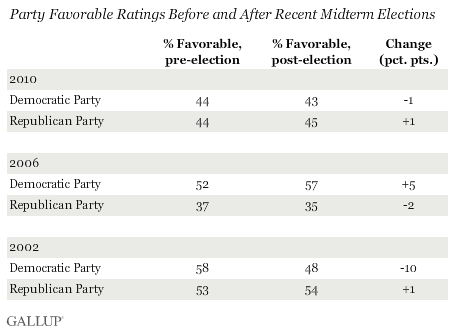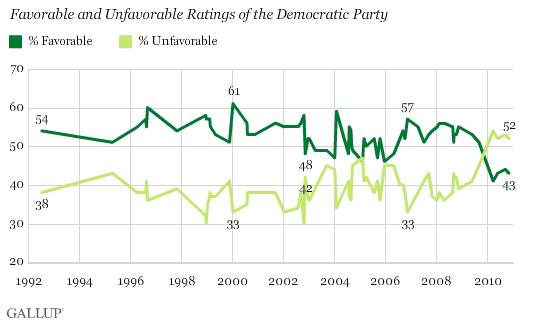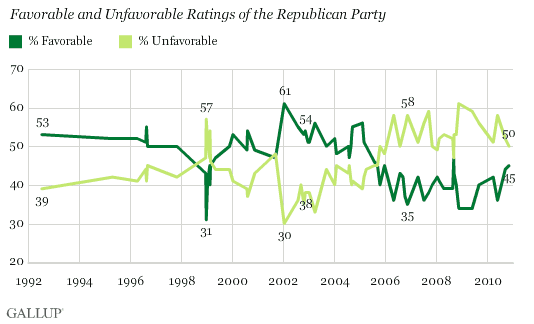PRINCETON, NJ -- Americans' opinions of the Republican Party are no better, and their opinions of the Democratic Party are no worse, after the recent midterm elections that saw Republicans make major gains in Congress. This contrasts with other recent midterm elections, in which at least one party's favorable rating either improved or declined in the aftermath of the election.

In 2006, after the Democrats took control of the House and the Senate in the midterm elections, the party's favorable rating increased from 52% to 57%, the highest Gallup has measured for the Democrats in the past seven years. The Republicans' favorable rating did not drop significantly after the 2006 midterms, but their 37% rating in October was already down from 42% in September, likely the result of poor publicity surrounding the Mark Foley sex scandal.
The Republican Party's favorable rating did not improve after the party's strong showing in the 2002 midterm elections, but the Democrats' image took a big hit -- falling from 58% to 48% favorable -- after their party failed to gain seats, a rarity for the opposition party in a midterm election.
Gallup did not measure party favorability shortly before the 1994 and 1998 midterm elections, so it is unclear whether those elections' results altered Americans' views of either political party.
The current party ratings, from a Nov. 4-7 USA Today/Gallup poll, show that most Americans continue to view both the Democratic and Republican parties more negatively than positively.
Americans' recent ratings of the Democratic Party have been the worst for the party in this Gallup trend dating to 1992. Prior to 2010, Gallup had just one measurement (in February 2005) in which the Democratic Party's unfavorable rating exceeded its favorable rating, and that was by one percentage point.

Americans' opinions of the Republican Party have generally been worse than their opinions of the Democratic Party since 1992, particularly in the last five years. While the public continues to hold a net-negative view of the GOP, the current 45% favorable rating is one of its best since 2005, and is up 11 points since just after the 2008 presidential election.

Implications
Though it became clear early on that the 2010 midterm elections would likely favor the GOP, it was unclear whether Americans would be giving Republicans a mandate if their party became the majority party in Congress. Gallup data from the late summer and early fall suggested that Americans were more likely voting to register their frustration with the Democrats than as an endorsement of the Republican Party. Now that the elections are over, Americans are no more positive toward the GOP than they were before, further suggesting the public is not necessarily embracing the Republican Party.
Results for this USA Today/Gallup poll are based on telephone interviews conducted Nov. 4-7, 2010, with a random sample of 1,021 adults, aged 18 and older, living in the continental U.S., selected using random-digit-dial sampling.
For results based on the total sample of national adults, one can say with 95% confidence that the maximum margin of sampling error is ±4 percentage points.
Interviews are conducted with respondents on landline telephones (for respondents with a landline telephone) and cellular phones (for respondents who are cell phone-only). Each sample includes a minimum quota of 150 cell phone-only respondents and 850 landline respondents, with additional minimum quotas among landline respondents for gender within region. Landline respondents are chosen at random within each household on the basis of which member had the most recent birthday.
Samples are weighted by gender, age, race, education, region, and phone lines. Demographic weighting targets are based on the March 2009 Current Population Survey figures for the aged 18 and older non-institutionalized population living in continental U.S. telephone households. All reported margins of sampling error include the computed design effects for weighting and sample design.
In addition to sampling error, question wording and practical difficulties in conducting surveys can introduce error or bias into the findings of public opinion polls.
View methodology, full question results, and trend data.
For more details on Gallup's polling methodology, visit www.gallup.com.
